国家茶叶质量安全工程技术研究中心与福建农林大学资源与环境学院/国际镁营养研究所联合开展了镁营养对茶园提质增效的研究,其成果发表在Scientia Horticulturae。

文章信息
原名:Magnesium is a nutritional tool for the yield and quality of oolong tea (Camellia sinensis L.) and reduces reactive nitrogen loss
译名:镁是提高乌龙茶产量、品质并减少活性氮损失的营养工具
期刊:Scientia Horticulturae
2021年影响因子:4.342
DOI:
https://doi.org/10.1016/j.scienta.2022.111590
文章亮点
施用镁肥可以通过提高茶芽密度从而提高乌龙茶产量
施镁可以提高乌龙茶茶叶的氨基酸含量并降低酚氨比
施用镁肥增加了乌龙茶收获部位氮和镁的累积量
施用镁肥可以降低茶园氧化亚氮排放量和硝态氮淋洗风险
镁肥在茶园绿色发展中的作用不容忽视
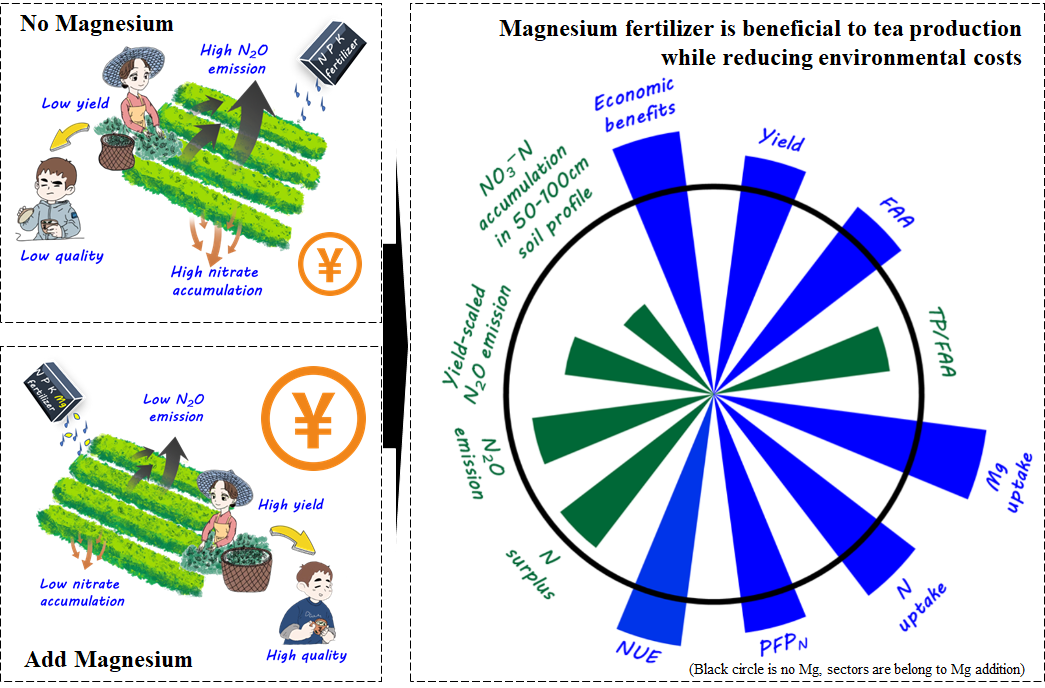
研究背景
镁作为作物生长的必需元素之一,在叶绿素合成、光合作用、光合产物分配、酶活化等生理生化过程均起着重要作用。此外,缺镁会严重影响作物的生长发育及其对养分的吸收利用。我国茶园主产区土壤存在严重的镁缺乏风险,缺镁是影响茶叶产量和品质形成的重要因素。过量施用N、P和K肥且忽略镁肥的施用加剧了茶园土壤酸化、离子拮抗作用和土壤镁淋洗,从而导致茶树缺镁风险的增加。综上,作者试图回答:1,镁是否会成为茶叶生产的重要限制因子,尤其是在土壤缺镁地区?2,镁肥能否作为一种提高作物氮素利用率的可持续农业生产的战略养分?
2017-2021在中国福建省泉州市安溪县开展乌龙茶镁肥用量(0、35、70
和140 kg MgO ha-1 yr-1)田间试验 (Fig. 1),以不施镁肥处理为对照(Mg0), 探讨不同镁肥施用量(Mg1、Mg2和
Mg3)对乌龙茶产量、品质、氮利用率及活性氮损失的影响。

Fig. 1. Diagram of the experimental plot (A), precipitation in the experimental area (B) and the arrangement of sampling and fertilization during 2017–2021 (C). The rainfall data came from WheatA software (China, http://www.wheata.cn/).
研究结果
结果表明:相比Mg0处理,施用镁肥(Mg1、Mg2和Mg3)可以显著增加14.1%春茶产量、18.4%秋茶产量和15.8%周年茶产量(春茶+秋茶)、改善茶叶品质并提高13.9-17.2%氮肥偏生产力和17.8-25.5%氮素利用率。相比Mg0处理,Mg1、Mg2和Mg3处理中茶芽(即采收部分)的氮吸收量分别显著提高19.5%, 25.8% 和21.5%。与此同时,镁肥的施用显著减少氮素盈余并降低活性氮损失风险。上述各项指标和经济效益在各施镁处理(Mg1、Mg2和Mg3)中均无显著差异。综上,如果不考虑土壤硝态氮淋洗风险,乌龙茶茶园镁肥推荐用量为35 kg MgO ha-1 yr-1,若考虑则为70 kg MgO ha-1 yr-1。上述结果表明,镁是茶叶生产中的一个关键限制因子并对茶叶生产有积极的影响,合理施用镁肥有利于茶叶生产的可持续发展。
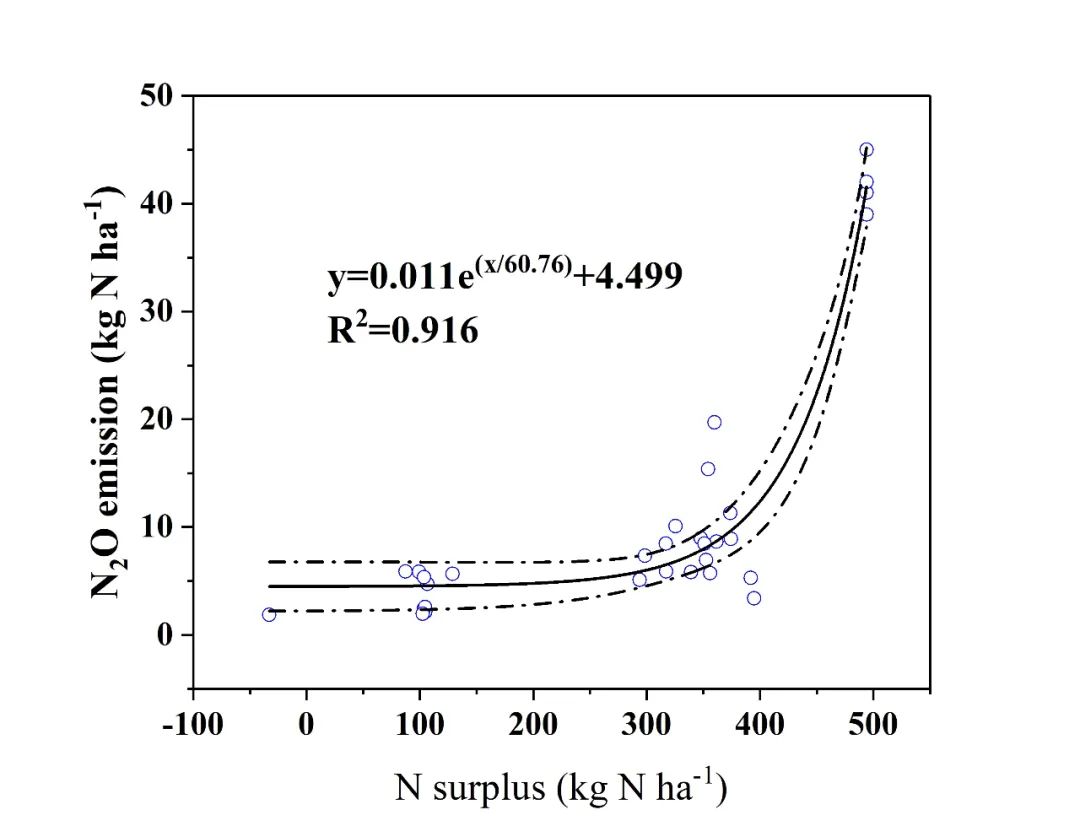
Fig.2. Exponential models of N2O emissions based on the N surplus in tea plantations (n=31).
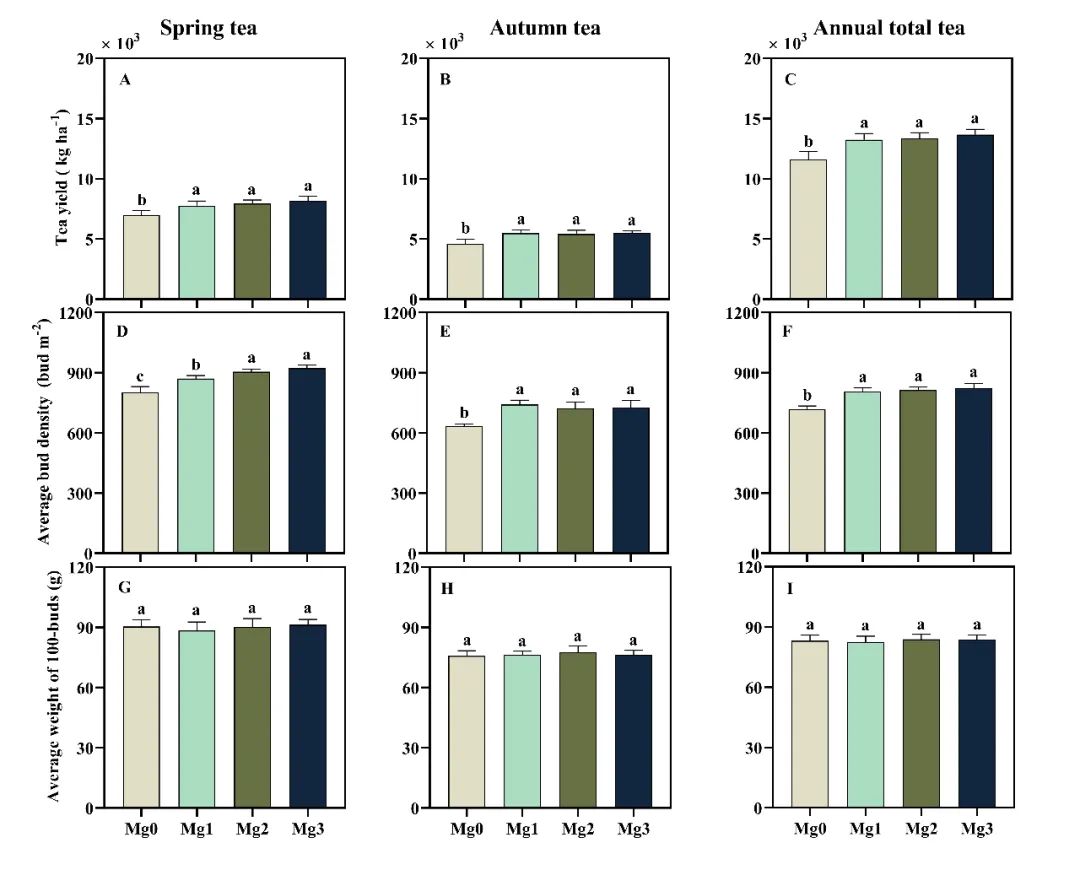
Fig.3. Comparison of yield and yield components among different treatments. A–C, yield of (A, spring tea; B, autumn tea; C, annual total tea); D–F, average bud density of (D, spring tea; E, autumn tea; F, annual total tea); G-I, average weight of 100-buds of (G, spring tea; H, autumn tea; I, annual total tea). The error bar indicates the standard deviation (SD.), different letters above each bar suggest significant differences at the 0.05 probability level by Duncan’s multiple range test.

Fig.4.Comparison of total free amino acid (FAA), tea polyphenol (TP), and the ratio of TP to FAA among different treatments. A–C, free amino acid of (A, spring tea; B, autumn tea; C, annual total tea); D–F, tea polyphenol of (D, spring tea; E, autumn tea; F, annual total tea); G-I, the ratio of TP to FAA of (G, spring tea; H, autumn tea; I, annual total tea). The error bar indicates the standard deviation (SD.), different letters above each bar suggest significant differences at the 0.05 probability level by Duncan’s multiple range test.
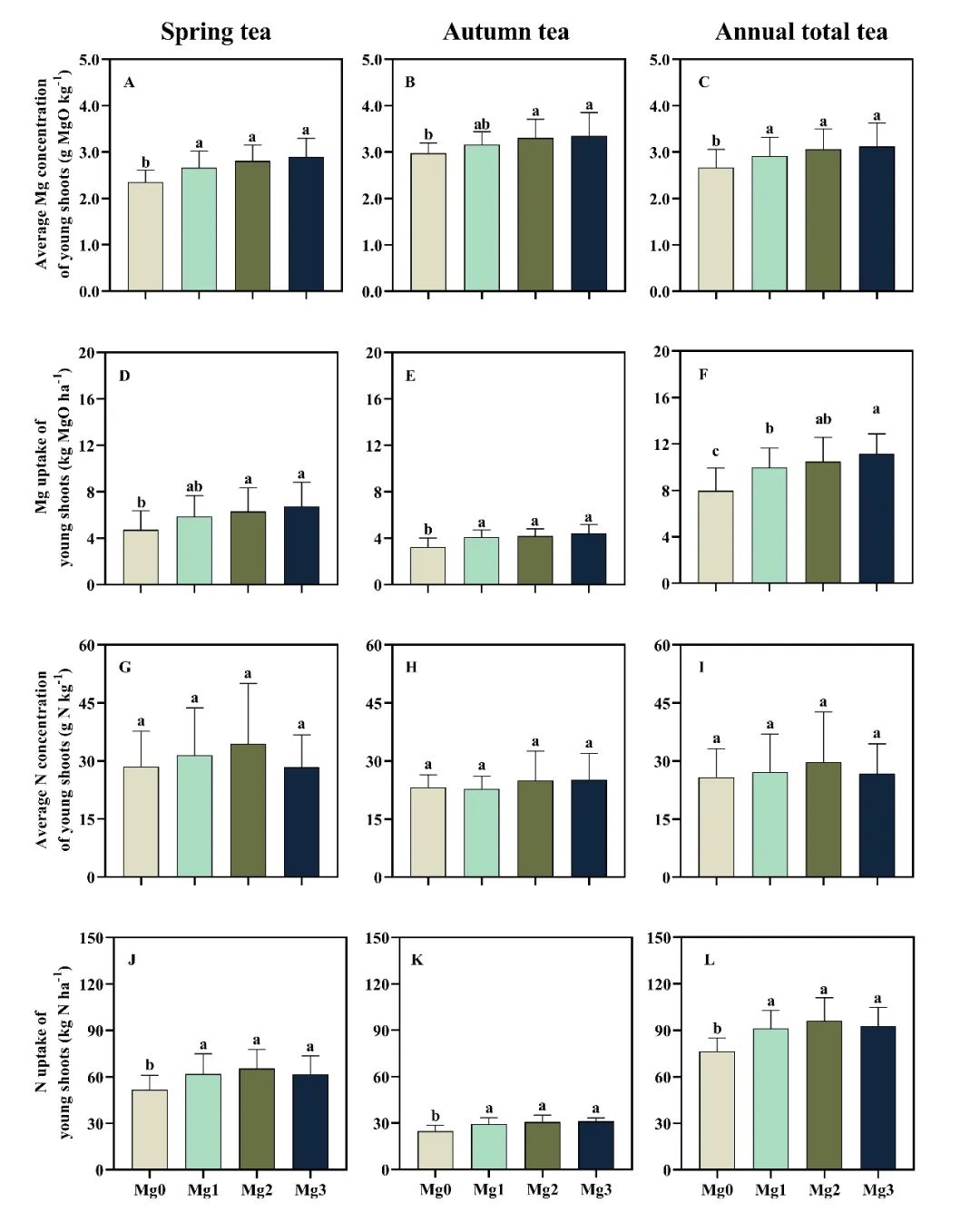
Fig.5. Effects of the magnesium application rate on the Mg concentration (A–C), Mg uptake (D–F), N concentration (G–I) and N uptake (J–L) of young shoots in spring tea, autumn tea and annual total tea. The error bar indicates the standard deviation (SD), and different letters above each boxplot suggest significant differences at the 0.05 probability level by Duncan’s multiple range test.

Fig.6. Comparison of PFPN (A), NUE (B) and NUPMg (C) among the different treatments. The error bar indicates the standard deviation (SD), and different letters above each boxplot suggest significant differences at the 0.05 probability level by Duncan’s multiple range test.

Fig.7. Effects of the magnesium application rate on the N surplus (A), N2O emissions (B) and tea yield-scale N2O emissions (C). The error bar indicates the standard deviation (SD), and different letters above each boxplot suggest significant differences at the 0.05 probability level by Duncan’s multiple range test.
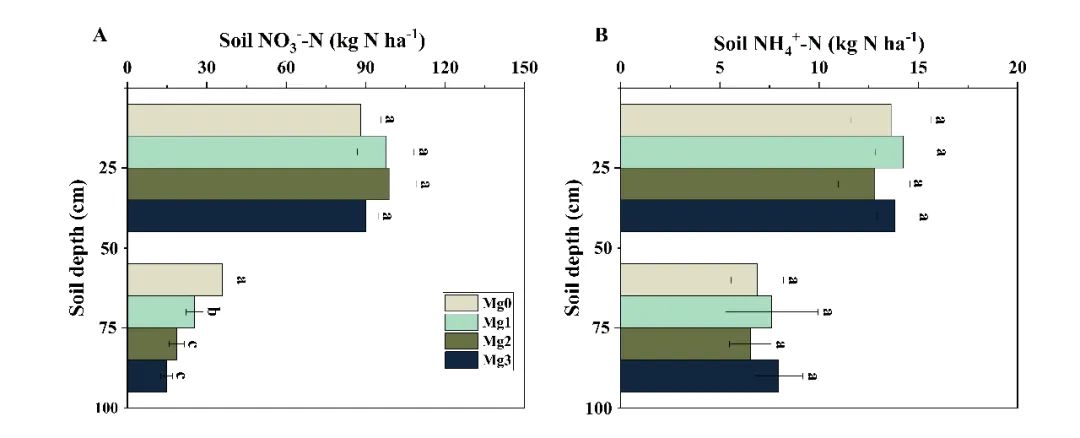
Fig.8.Distribution of soil NO3--N (A) and NH4+-N (B) in the 0-100 cm soil profile after spring tea harvest in 2020.The error bar indicates the standard deviation (SD), and different letters above each bar suggest significant differences at the 0.05 probability level; ns indicates no significant differences between treatments at the 0.05 probability level by Duncan’s multiple range test.
研究结论
本研究结果表明,镁是茶叶生产中的一个关键限制因子,尤其是在缺镁地区。镁肥的施用可以显著提高茶芽数,从而显著增加春茶产量(14.1%)、秋茶产量(18.4%)和周年茶产量(15.8%)。施用镁肥可以通过提高茶叶氨基酸含量(13.7%)并降低酚氨比(14.6%),从而提高茶叶品质。此外,施用镁肥提高茶叶氮素年吸收量(22.3%)和氮素利用率(21.4%),从而降低茶园生产过程的氧化亚氮排放量(11.8%)和土壤硝态氮淋洗(45.3%)。安溪县乌龙茶生产中适宜的镁肥用量为35-70 kg MgO ha-1 yr-1。上述结果表明,镁可以作为一种提高茶树氮素利用率和促进茶叶可持续生产的战略营养物质。结合实际生产中作物缺镁的现象日趋严重,因此建议加强作物镁营养知识的传播和普及应用。
